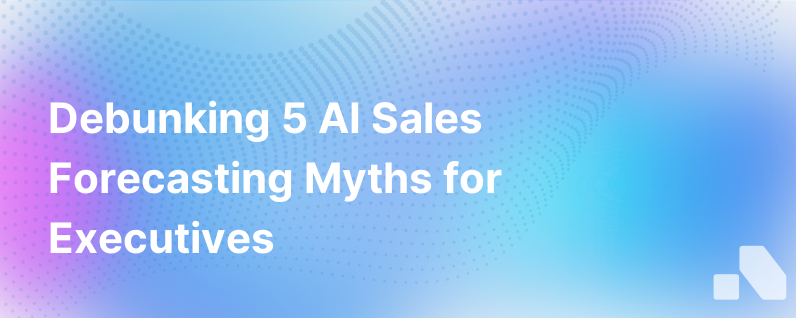
The omnipresence of Artificial Intelligence (AI) across multiple sectors has led to a transformative wave in the way businesses operate. In the realm of sales, AI's introduction promises to revolutionize forecasting, promising improved accuracy and invaluable insights. However, with AI's advent comes a plethora of misconceptions. Debunking these myths is crucial for organizations to embrace AI's full potential in sales forecasting.
Here's an in-depth look at the five most common myths surrounding the application of artificial intelligence in sales forecasting:
Myth 1: AI in Sales Forecasting Completely Eliminates Human Input
One widespread myth is that AI renders salespeople obsolete, automating the process to the extent that human judgment and experience become redundant. This is far from the truth. While AI enhances efficiency and predictive accuracy, it doesn't replace the nuanced understanding that sales teams bring to the table. Human insight is vital in interpreting and applying AI-driven forecasts. Sales professionals use their judgment to qualify AI-generated predictions, factor in variable market conditions, and understand complex buyer behaviors that AI may not fully decode. AI is a tool to augment human capabilities, not replace them.
Myth 2: AI Makes Flawless Predictions
Expecting AI to deliver flawless sales forecasts is a misconception born from misunderstanding AI's capabilities. Machine learning and AI improve forecasting by identifying trends and patterns invisible to the human eye, but these predictions are based on available data. The quality and completeness of this data fundamentally influence the accuracy of AI projections. Moreover, AI models can be affected by the same biases present in the training data, and unforeseen market fluctuations can also skew results. The takeaway is that while AI significantly improves forecast reliability, perfection in prediction is an unrealistic standard for any system.
Myth 3: Implementing AI in Sales Forecasting Is Ludicrously Expensive
The belief that AI implementation requires a prohibitive investment often discourages organizations from pursuing AI solutions. It's true that the earliest AI applications necessitated substantial spending. However, with the evolution of technology and the emergence of service-oriented platforms, AI has become remarkably more accessible. Today, many SaaS (Software as a Service) providers offer affordable AI-powered sales forecasting tools tailored to various business sizes and budgets. Furthermore, the return on investment via improved forecast accuracy, optimized inventory management, and streamlined operations often outweighs the initial costs.
Myth 4: AI Forecasting Is Too Complex to Integrate and Utilize
Complexity and usability are commonly misattributed barriers to AI adoption in sales forecasting. While the underlying technology of AI algorithms is undoubtedly sophisticated, the user end of AI-powered tools is designed for accessibility and ease of use. Integration concerns have largely been mitigated by providers who develop AI solutions that dovetail with existing CRM and ERP systems. The emphasis is on user-friendly interfaces and actionable insights, parallel to any contemporary software tool, ensuring a smooth integration into sales operations.
Myth 5: AI Is Unnecessary If You Already Have a Working Forecasting Process
"Why fix what isn't broken?" is an adage some businesses apply to their traditional sales forecasting processes. While existing methods may work, they may also cap potential growth. AI doesn't simply automate existing processes; it enhances them. It leverages historical data, real-time analytics, and predictive modeling to generate insights beyond the human analytical capability. This proactive intelligence can identify risks and opportunities ahead of time, allowing organizations to act swiftly and strategically. By dismissing AI, companies may miss out on leveraging such benefits to stay competitive and propel forward.
Embracing the Future with AI-Enhanced Sales Forecasting
In conclusion, when we strip away the myths surrounding AI in sales forecasting, we uncover an opportunity to bolster our strategic decision-making with cutting-edge technology. By understanding what AI can and cannot do, organizations can better position themselves to capitalize on its benefits. AI should be seen as a partner to the sales force, providing foresight and precision to sales projections while leaving the critical thinking, emotional intelligence, and relationship-building to human experts.
As businesses look to a data-driven future, the interplay between human acumen and artificial intelligence stands to unlock unprecedented avenues for growth, optimization, and adaptability. AI promises a robust framework for sales forecasting—one that equips teams to navigate the ebbs and flows of the marketplace with greater confidence and intelligence.
In harnessing this power, platforms such as Aomni offer invaluable tools that assimilate real-time data, delivering actionable insights for sales strategies in minutes rather than hours. Aomni's seamless integration, paired with its ease of use, illustrates the democratization of AI—bringing its transformative potential to the doorstep of any business eager to trailblaze into a future of informed, strategically poised sales operations.